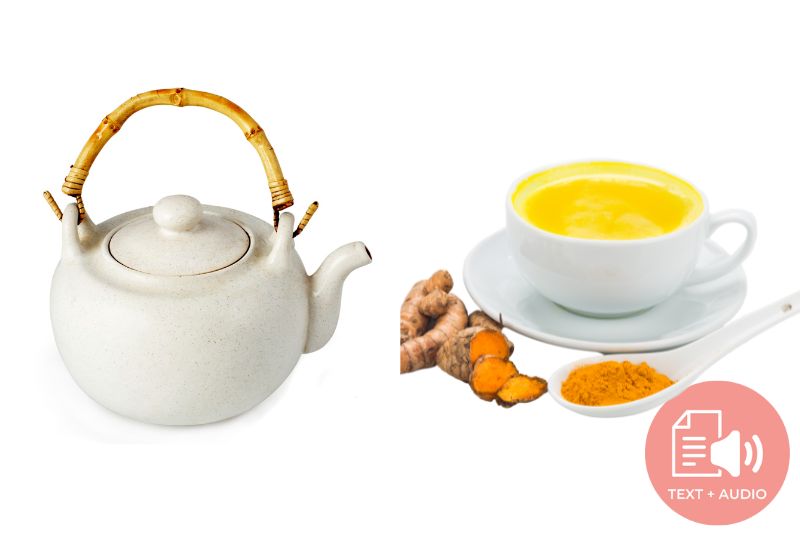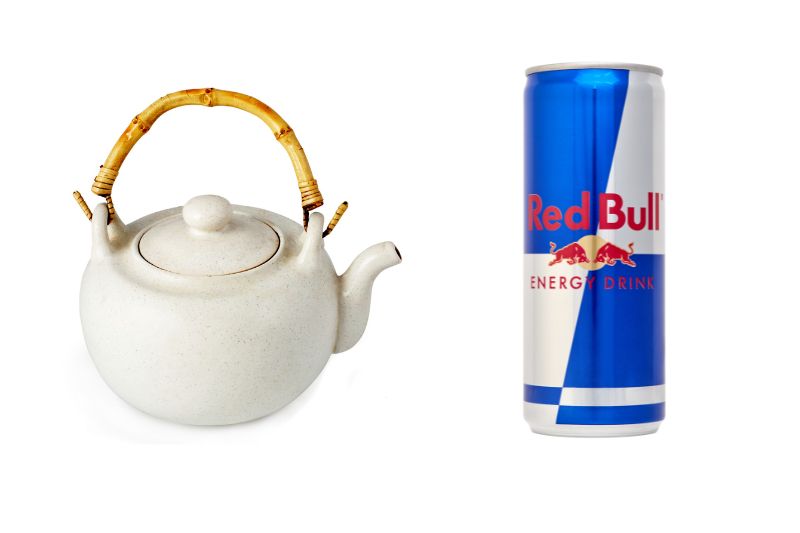Japanese Green Tea and Chamomile garnered a cult following over the years. People drink these beverages for different reasons, some prefer their taste while others often drink them for their wonderful health benefits. Let’s find out which drink suits your lifestyle and health needs so you can figure whether you’re going to purchase Japanese Green Tea or Chamomile Tea.
While both teas are widely consumed across the globe, they couldn’t be more different in origin and effect. Japanese Green Tea, known for its slightly grassy flavor and energizing qualities, has been a staple in East Asian wellness traditions for centuries. On the other hand, Chamomile, with its floral aroma and calming nature, has roots in ancient Egyptian and European herbal medicine. Whether you're looking for a morning pick-me-up or a soothing bedtime companion, these two teas cater to entirely different moments in your daily routine—and understanding their unique profiles can help you sip smarter.
1. BRAINPOWER: Green Tea makes you feel wide awake and hyperfocus while Chamomile Tea makes you feel centered… which is better for a busy workday?
Both, are honestly excellent to drink especially when your schedule is always jam-packed. However, green tea contains caffeine which will give us the energy boost that we needed which will power us throughout the day. Chamomile, on the other hand, does not contain caffeine. But, research has shown that luteolin in chamomile tea improves cognitive functioning when you’re awake. That being said, it is perfect when you want to center yourself and feel calm while being mindful of your tasks.
But, according to research, if you want to really boost your brainpower, it is best that you drink green tea since it has been found that green tea extract enhances the cognitive functions, in particular, the working memory.
That said, choosing between the two often comes down to what kind of mental state you need. Green tea is ideal when you're preparing for a high-focus task—like tackling spreadsheets, studying, or managing meetings—thanks to its combination of caffeine and L-theanine. This unique amino acid moderates caffeine’s intensity, promoting alertness without the jitteriness often associated with coffee. Meanwhile, Chamomile Tea can be your ally during brainstorming sessions, creative writing, or meditation-based work, where clarity and emotional balance matter more than sheer energy. So, while green tea sharpens the mind for performance, chamomile grounds it for presence—each offering its own kind of brainpower advantage depending on your daily demands.
2. GOOD SLEEP: Chamomile has mild and natural sedating properties that allow you to have a good night’s sleep, and so is Green Tea… which tea will help me get a good night’s sleep?
As I’ve mentioned previously, both green tea and chamomile tea helps improve a person’s quality of sleep. However, chamomile is widely regarded as a mild tranquilizer and sleep-inducer. Sedative effects may be due to the flavonoid, apigenin that binds to benzodiazepine receptors in the brain.
Studies have shown that ten cardiac patients are reported to have immediately fallen into a deep sleep lasting for 90 minutes after drinking chamomile tea. Chamomile extracts exhibit benzodiazepine-like hypnotic activity which makes people feel relaxed and sleepy.
Green tea, particularly varieties like Hojicha or Bancha, which are low in caffeine, can also promote better sleep when consumed in moderation and earlier in the evening. These types of green tea contain theanine, an amino acid known to reduce stress and improve sleep quality by enhancing alpha brain waves associated with relaxation. However, timing is key—drinking caffeinated green tea too close to bedtime may disrupt sleep for some individuals. If you're sensitive to caffeine, chamomile remains the superior bedtime choice. For others who enjoy a warm drink after dinner but don’t want to go fully caffeine-free, a lightly brewed green tea could offer a soothing, sleep-supportive ritual without complete sedation.
3. PRE-WORKOUT DRINK: Green Tea will give you a boost of energy perfect for your morning or afternoon workout sessions but will Chamomile Tea an alternative?
Both teas are believed to aid in weight management, however, green tea has the highest concentration of ECGC. ECGC is a potent antioxidant that has been shown to be beneficial to heart health, lowering the risks for cancers and neurological diseases, and even weight loss.
To get the most from its metabolic benefits, it's best to drink at least 3 cups per day. Green tea is wonderful to drink any time of day and tastes great with a little drizzle of honey. It may be especially beneficial to drink green tea before a workout since in one small study, extracts from green tea helped men burn 17% more fat during a 30-minute, moderate-intensity cardio workout. Which makes it an excellent pre-workout drink for it gives you more energy while it burns fat faster.
Chamomile tea, while not typically used for energy, can play a supporting role in your fitness routine—just in a different way. Known for its muscle-relaxing and anti-inflammatory properties, chamomile may help reduce post-workout soreness or tension when consumed after exercise. Some athletes even use it as a natural remedy to ease joint stiffness or promote quicker recovery. Though it won't provide the same fat-burning boost as green tea, drinking chamomile beforehand could be helpful if you're engaging in a low-intensity activity like yoga, stretching, or walking. Its calming effects might ease performance anxiety, allowing for a more focused and mindful workout.
4. SKIN RELIEF: Chamomile Tea contains skin calming and healing properties that help heal wounds but so does Green Tea… which will heal wounds faster?
Green tea has anti-oxidant and anti-inflammatory properties and may enhance the wound healing process. However, chamomile has been used since antiquity to treat wounds and urge healing, thanks to its anti-inflammatory and antimicrobial properties. A small yet more recent study found that chamomile significantly promoted wound healing. Several studies have found that topical chamomile treatments are effective in soothing eczema and mild inflammatory skin conditions.
A lot of people swear by chamomile to reduce acne and the redness that comes with it; which makes sense considering its prevalence in so many skincare products thanks to its calming, soothing, and moisturizing properties which also helps restore skin barriers while improving the skin’s pH level.
Green tea, meanwhile, has carved a strong presence in the skincare industry due to its high levels of catechins, especially epigallocatechin gallate (EGCG), which protect the skin from UV damage and environmental stressors. Its antioxidant strength fights free radicals, which are responsible for premature aging, wrinkles, and dullness. Green tea’s astringent nature also helps tighten skin and minimize pores, making it ideal for oily or acne-prone skin. When used topically or consumed regularly, it may even reduce sebum production and improve skin elasticity. While chamomile excels in calming and healing sensitive skin, green tea offers a powerful layer of protection and rejuvenation—making both teas valuable in different ways for long-term skin health.
5. EYEBAGS REMEDY: Green Tea contains powerful brightening and de-puffing properties while Chamomile also contains anti-inflammatory and soothing properties… which will be more effective?
As I mentioned earlier, chamomile tea helps soothes wounds and acne which is why it is also an effective remedy for puffy eyes. However, by placing brewed tea bags on the eyes for a short time period allows the tannins in the tea to treat puffy eyes and dark circles. Green tea bags reduce swelling and tighten the skin around the eyes.
The caffeine reduces puffiness by shrinking the blood vessels. Green tea works on dark circles by decreasing the dilation of the blood vessels under the eyes. The astringent nature of the tannins constricts the blood vessels and capillaries under the eyes.
Chamomile tea, in contrast, shines when it comes to soothing irritated or sensitive under-eye skin, especially for those prone to allergies or dryness. Its gentle anti-inflammatory compounds, like apigenin, reduce puffiness without stimulating the skin, making it a safer option for people with delicate or reactive skin types. The naturally calming aroma of chamomile also helps promote relaxation, which can indirectly reduce eye fatigue caused by stress or lack of sleep. If you're dealing with inflammation and want a gentler approach, chamomile tea bags chilled in the fridge make a refreshing compress that calms the skin and refreshes the eyes, especially after a long day or a sleepless night.
6. HEADACHE AND MIGRAINE REMEDY: Chamomile Tea and Green Tea both relieve headaches and migraines; which is more effective?
Green tea is rich in antioxidants and has analgesic properties, this is a reason why green tea is thought to be an excellent drink to soothe headaches. However, Chamomile tea is one of the most effective herbal teas available to relax the body and induce sleep. The herb depresses the nervous system and is effective in calming the body while alleviating stress headaches that can develop. Those who suffer from anxiety can consume the beverage once or twice a day to prevent the migraines from returning.
That said, the type of headache you’re experiencing may influence which tea is more effective. Green tea is particularly helpful for tension headaches caused by eye strain or long hours of concentration, thanks to its moderate caffeine content that improves blood flow to the brain and reduces inflammation. On the flip side, chamomile is better suited for migraines triggered by emotional stress or hormonal changes, offering deep relaxation without the stimulation of caffeine. For some people, even small amounts of caffeine can worsen migraine symptoms, making chamomile the safer and more calming option. Ultimately, understanding your body’s response to each can help you decide which brew is best for your head pain.
7. BODY ODOR PREVENTION: Do you not like using deodorant? Say no more! Green Tea and Chamomile Tea have anti-body odor properties, but what will work best?
Chamomile has anti-bacterial, astringent, and deodorant properties that make it a remedy for treating excessive sweating. Its antibacterial property helps to eliminate the bacteria which produce the body odor and sweat. Its astringent property helps to constrict the sweat glands and deodorant properties counteracting the odor.
However, antioxidant-rich green tea is a wonder drink that can help prevent bad breath, body odor, and stinky feet. Green tea supports detoxification by aiding the production of glutathione, a carrier-antioxidant that eliminates harmful toxins from the body. The fewer the toxins in your body, the better your body will smell. The polyphenols in green tea also help freshen your breath and destroy the compounds that cause bad breath.
All you have to do:
- Put 1 to 2 teaspoons of green tea leaves in a cup.
- Pour hot water over it.
- Cover and steep for 2 to 3 minutes.
- Strain, add a little raw honey, and drink it.
- Add few ice cubes.
- Drink 3 to 4 cups of green tea daily.
8. MENSTRUAL CRAMPS REMEDY: Say goodbye to period pains when you drink Chamomile Tea or Green Tea, but will the soothing properties of Chamomile prevail over Green Tea?
Green tea is not only rich in antioxidants and anti-inflammatory properties while also help promotes blood flow, but green tea also contains caffeine which DOES NOT mix well with menstrual cramps.
This is why drinking chamomile tea is a much better alternative for several studies that have linked chamomile tea to reduced severity of menstrual cramps. A 2010 study, found that consuming chamomile tea for a month could reduce the pain of menstrual cramps. Women in the study also reported less anxiety and distress associated with period pain.
Chamomile tea’s antispasmodic properties are especially valuable during menstruation, as they help relax the uterus and reduce muscle contractions, which are often the root cause of cramping. Additionally, chamomile promotes better mood regulation thanks to its mild sedative effects, making it a comforting drink during emotionally turbulent times in the cycle. While green tea may provide antioxidant support, its caffeine content can exacerbate bloating and irritability for some women. For a gentle, all-natural approach to managing both the physical and emotional symptoms of menstruation, chamomile tea stands out as the more effective and holistic remedy.
9. HAIR GROWTH: Green Tea is dubbed as the “natural hair extensions” but will Chamomile do the same?
Chamomile tea is a wonderful remedy for treating dandruff and itchy scalp and in some instances helps with hair growth too, thanks to its soothing and nourishing properties. However, green tea is particularly good for hair. It is rich in catechins, which help to reduce dihydrotestosterone (DTH), responsible for hair loss. As a result, green tea stops hair fall. It helps to fight dryness of the scalp and dandruff. Green tea contains essential compounds, such as polyphenol, which are good for hair roots and hair follicles, which leads to hair regrowth.
Beyond internal consumption, both teas can also be used topically as part of a hair care routine. Chamomile tea, when used as a hair rinse, can naturally brighten blonde tones and bring out golden highlights, making it a popular choice for those with lighter hair. It also soothes scalp irritation, reducing inflammation that can hinder healthy hair growth. Green tea, on the other hand, can be brewed and applied directly to the scalp to stimulate circulation and strengthen follicles, potentially increasing hair density over time. While chamomile supports scalp health and beauty, green tea offers a more targeted solution for stimulating growth and preventing hair loss—making both powerful allies depending on your hair goals.
10. UPSET STOMACH RELIEF: Chamomile Tea helps in relaxing stomach muscles that can relieve an upset stomach, however, can Green Tea do the same?
Green tea has been heavily researched for its many potential health benefits. It was historically used as a natural remedy for diarrhea and infection from Helicobacter pylori, a strain of bacteria that can cause stomach pain, nausea, and bloating. It may relieve other stomach issues as well. Keep in mind that it’s best to stick to 1 - 2 cups of green tea per day, as excessive intake, is linked to side effects like nausea and stomach upset due to its high caffeine content
However, Chamomile tea can relieve stomach cramps, motion sickness, diarrhea, nausea, indigestion, and abdominal gas. This plant contains chemicals called flavonoids, nutrients that give chamomile its medicinal properties. Studies have shown that chamomile has anti-inflammatory and antimicrobial capabilities. Acid reflux causes stomach acid to move back into your esophagus. This often leads to painful inflammation in the esophagus. It’s possible that chamomile’s anti-inflammatory effects may help.
According to research, an herbal preparation that included chamomile extract lowered gastric acidity as well as a commercial antacid. The preparation was also more effective than antacids at preventing secondary hyperacidity. Stress is a common acid reflux trigger. A 2015 study reviewed the prevalence of lifestyle factors associated with gastroesophageal disease (GERD). GERD is a more severe form of acid reflux. Study participants reported “feelings of continued stress” as the number one factor that made their symptoms worse. In theory, drinking chamomile tea may help reduce stress. So it may also help reduce or prevent stress-related acid reflux episodes.
What truly sets chamomile apart in digestive care is its ability to calm both the gut and the mind, which can be particularly helpful for those whose stomach issues are stress-induced. Its gentle nature makes it suitable even for children or individuals with sensitive digestive systems. On the other hand, green tea is better suited for addressing bacterial imbalances or inflammation-driven conditions, especially when consumed in moderation. Some studies suggest that green tea polyphenols can help protect the lining of the stomach and intestines. However, its caffeine content can be a double-edged sword—offering alertness on one hand, but potentially aggravating symptoms like acid reflux or cramping on the other. For sensitive stomachs or nighttime digestion, chamomile remains the safer and more effective option.
In conclusion...
Both, Japanese Green Tea and Chamomile Tea have their own set of health benefits that anyone can incorporate into their everyday routine. That being said, Japanese Green Tea and Chamomile complement each other and it can be beneficial if you both have it in your pantry except if you’re allergic to flowers since chamomile is derived from a flower. Both teas matched up when it came to health-related properties and shared other similarities. Yes, they did differ in taste, pricing, impurities, and culture, but overall it comes down to what you like.
Whether you're starting your morning with a gentle buzz from green tea or winding down at night with a soothing cup of chamomile, each tea brings something meaningful to your day. You don’t have to choose just one—many tea lovers rotate between both depending on their needs, mood, and the time of day. The real magic happens when you listen to your body and discover which brew supports your lifestyle best. In the end, the perfect cup of tea isn't just about health—it's about how it makes you feel.
Which tea will your drink, today?
Join Us On Private Facebook Group
Are you part of our Private Facebook Group, Green Tea Club?
Here is an example of a conversation we have in our group. Join all the tea lovers here (free) to share what tea you love. Click here to join
Click here to join Green Tea Club Private Facebook Group
Get Free Bonus Books

Sign up for free to the Green Tea Club to get advice and exclusive articles about how to choose Japanese Tea, and tips, tricks, and recipes for enjoying Japanese tea.
About the author
Kei Nishida
Author, CEO Dream of Japan
Certification: PMP, BS in Computer Science
Education: Western Washington University
Kei Nishida is a passionate Japanese green tea connoisseur, writer, and the founder and CEO of Japanese Green Tea Co., a Dream of Japan Company.
Driven by a deep desire to share the rich flavors of his homeland, he established the only company that sources premium tea grown in nutrient-rich sugarcane soil—earning multiple Global Tea Champion awards.
Expanding his mission of introducing Japan’s finest to the world, Kei pioneered the launch of the first-ever Sumiyaki charcoal-roasted coffee through Japanese Coffee Co. He also brought the artistry of traditional Japanese craftsmanship to the global market by making katana-style handmade knives—crafted by a renowned katana maker—available outside Japan for the first time through Japanese Knife Co.
Kei’s journey continues as he uncovers and shares Japan’s hidden treasures with the world.
Learn more about Kei










I just got back in touch with tea. It was chamomile (manzinilla) tea first. The first cup made me feel like I was back in Spain. I lived in Spain for 7 years and they drink a lot of it. Also added green tea because I forgot how much of it I drank while in Japan. One week and I feel it. I have a catastrophic disease going in to second remission and I feel it helping. Manzinilla morning and evening and green tea twice during the day.